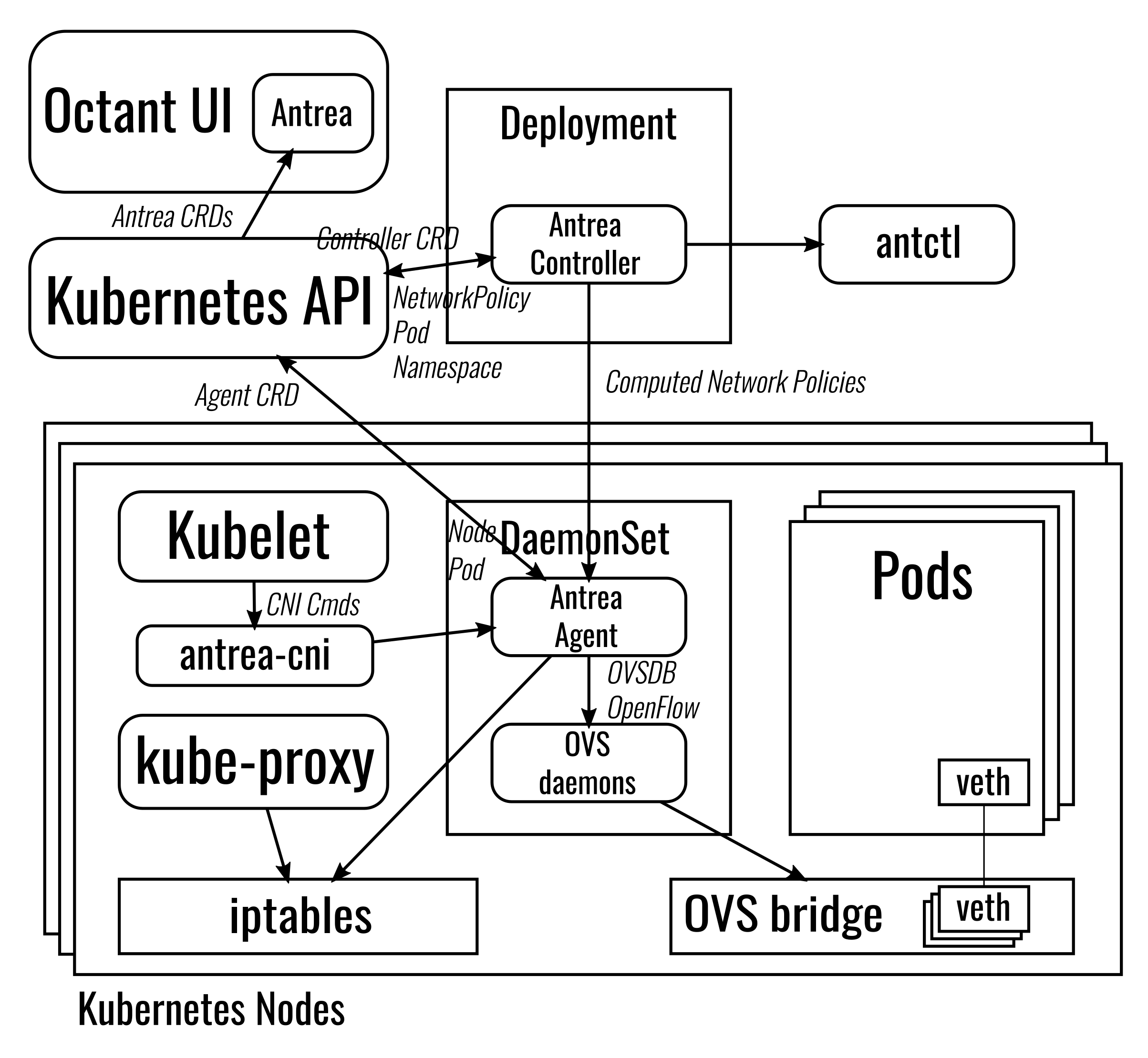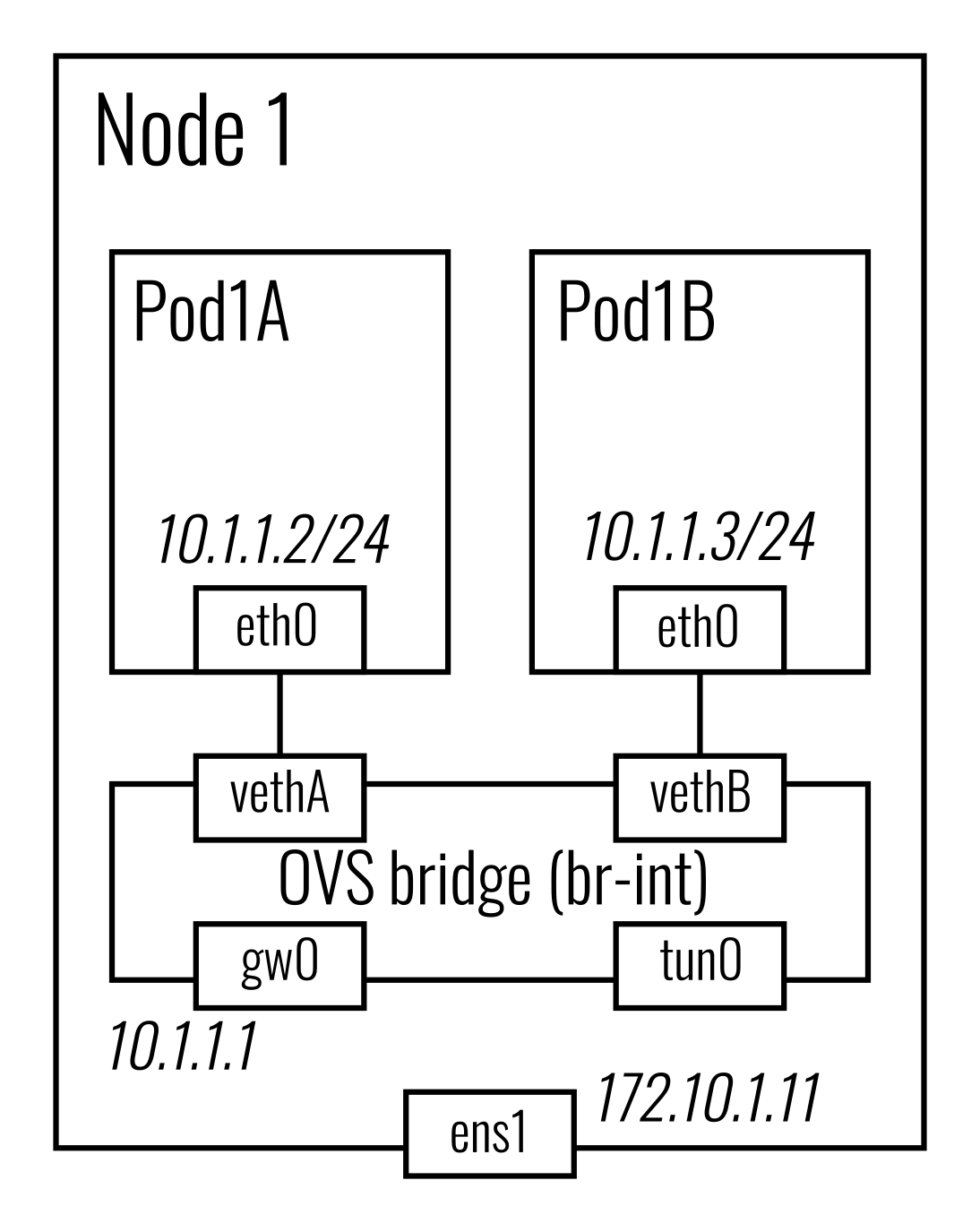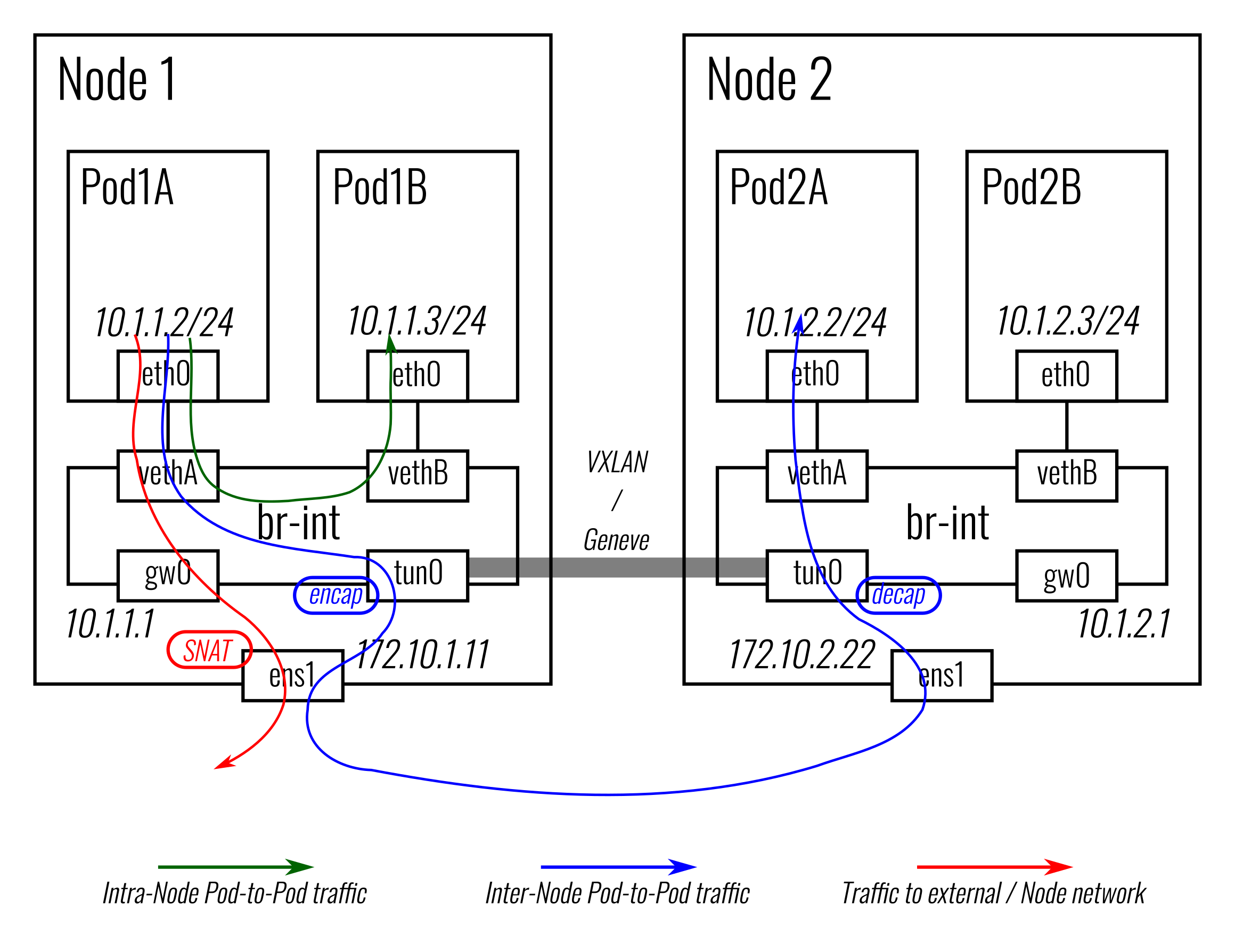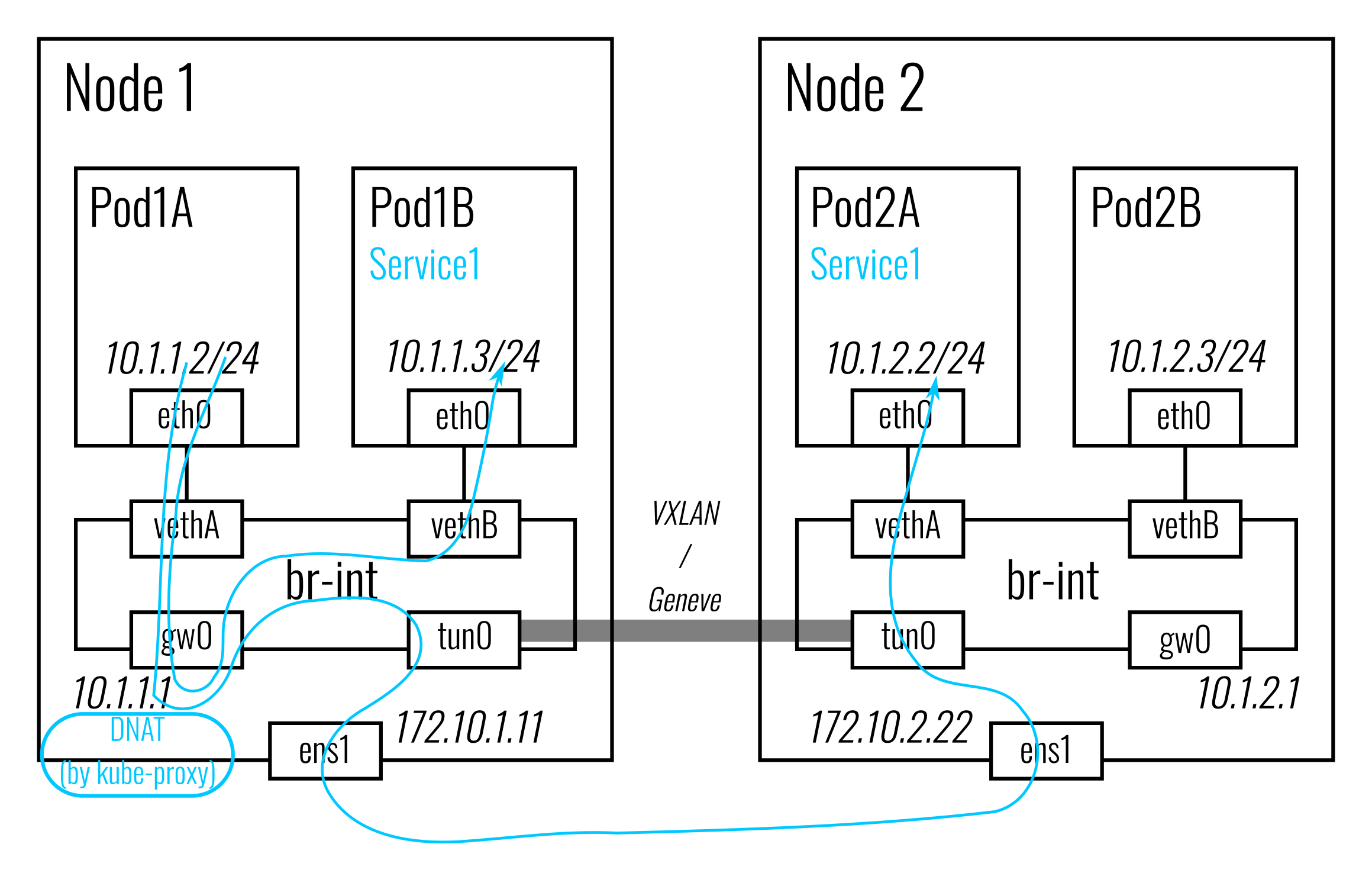Documentation
Introduction
Cloud Deployment
Reference
- Antrea Network Policy
- antctl
- Architecture
- Traffic Encryption (Ipsec / WireGuard)
- Securing Control Plane
- Troubleshooting
- OS-specific Known Issues
- OVS Pipeline
- Feature Gates
- Network Flow Visibility
- Traceflow Guide
- NoEncap and Hybrid Traffic Modes
- Egress Guide
- NodePortLocal Guide
- Versioning
- Antrea API Groups
- Antrea API Reference
Windows
Integrations
Cookbooks
Developer Guide
Project Information
Antrea Architecture
Antrea is designed to be Kubernetes-centric and Kubernetes-native. It focuses on and is optimized for networking and security of a Kubernetes cluster. Its implementation leverages Kubernetes and Kubernetes native solutions as much as possible.
Antrea leverages Open vSwitch as the networking data plane. Open vSwitch is a high-performance programmable virtual switch that supports both Linux and Windows. Open vSwitch enables Antrea to implement Kubernetes Network Policies in a high-performance and efficient manner. Thanks to the “programmable” characteristic of Open vSwitch, Antrea is able to implement an extensive set of networking and security features and services on top of Open vSwitch.
Some information in this document and in particular when it comes to the Antrea Agent is specific to running Antrea on Linux Nodes. For information about how Antrea is run on Windows Nodes, please refer to the Windows design document.
Components
In a Kubernetes cluster, Antrea creates a Deployment that runs Antrea
Controller, and a DaemonSet that includes two containers to run Antrea Agent
and OVS daemons respectively, on every Node. The DaemonSet also includes an
init container that installs the CNI plugin - antrea-cni - on the Node and
ensures that the OVS kernel module is loaded and it is chained with the portmap
and bandwidth CNI plugins. All Antrea Controller, Agent, OVS daemons, and
antrea-cni bits are included in a single Docker image. Antrea also has a
command-line tool called antctl, and an
Octant
UI plugin.

Antrea Controller
Antrea Controller watches NetworkPolicy, Pod, and Namespace resources from the Kubernetes API, computes NetworkPolicies and distributes the computed policies to all Antrea Agents. Right now Antrea Controller supports only a single replica. At the moment, Antrea Controller mainly exists for NetworkPolicy implementation. If you only care about connectivity between Pods but not NetworkPolicy support, you may choose not to deploy Antrea Controller at all. However, in the future, Antrea might support more features that require Antrea Controller.
Antrea Controller leverages the
Kubernetes apiserver library
to implement the communication channel to Antrea Agents. Each Antrea Agent
connects to the Controller API server and watches the computed NetworkPolicy
objects. Controller also exposes a REST API for antctl on the same HTTP
endpoint. See more information about the Controller API server implementation
in the
Controller API server section.
Controller API server
Antrea Controller leverages the Kubernetes apiserver library to implement its own API server. The API server implementation is customized and optimized for publishing the computed NetworkPolicies to Agents:
- The API server keeps all the state in in-memory caches and does not require a datastore to persist the data.
- It sends the NetworkPolicy objects to only those Nodes that need to apply the NetworkPolicies locally. A Node receives a NetworkPolicy if and only if the NetworkPolicy is applied to at least one Pod on the Node.
- It supports sending incremental updates to the NetworkPolicy objects to Agents.
- Messages between Controller and Agent are serialized using the Protobuf format for reduced size and higher efficiency.
The Antrea Controller API server also leverages Kubernetes Service for:
- Service discovery
- Authentication and authorization
The Controller API endpoint is exposed through a Kubernetes ClusterIP type Service. Antrea Agent gets the Service’s ClusterIP from the Service environment variable and connects to the Controller API server using the ClusterIP. The Controller API server delegates authentication and authorization to the Kubernetes API - the Antrea Agent uses a Kubernetes ServiceAccount token to authenticate to the Controller, and the Controller API server validates the token and whether the ServiceAccount is authorized for the API request with the Kubernetes API.
Antrea Controller also exposes a REST API for antctl using the API server HTTP
endpoint. It leverages
Kubernetes API aggregation
to enable antctl to reach the Antrea Controller API through the Kubernetes
API - antctl connects and authenticates to the Kubernetes API, which will
proxy the antctl API requests to the Antrea Controller. In this way, antctl
can be executed on any machine that can reach the Kubernetes API, and it can
also leverage the kubectl configuration (kubeconfig file) to discover the
Kubernetes API and authentication information. See also the
antctl section.
Antrea Agent
Antrea Agent manages the OVS bridge and Pod interfaces and implements Pod networking with OVS on every Kubernetes Node.
Antrea Agent exposes a gRPC service (Cni service) which is invoked by the
antrea-cni binary to perform CNI operations. For each new Pod to be created on
the Node, after getting the CNI ADD call from antrea-cni, the Agent creates
the Pod’s network interface, allocates an IP address, connects the interface to
the OVS bridge and installs the necessary flows in OVS. To learn more about the
OVS flows check out the
OVS pipeline doc.
Antrea Agent includes two Kubernetes controllers:
- The Node controller watches the Kubernetes API server for new Nodes, and creates an OVS (Geneve / VXLAN / GRE / STT) tunnel to each remote Node.
- The NetworkPolicy controller watches the computed NetworkPolicies from the Antrea Controller API, and installs OVS flows to implement the NetworkPolicies for the local Pods.
Antrea Agent also exposes a REST API on a local HTTP endpoint for antctl.
OVS daemons
The two OVS daemons - ovsdb-server and ovs-vswitchd run in a separate
container, called antrea-ovs, of the Antrea Agent DaemonSet.
antrea-cni
antrea-cni is the
CNI plugin
binary of Antrea. It is executed by kubelet for each CNI command. It is a
simple gRPC client which issues an RPC to Antrea Agent for each CNI command. The
Agent performs the actual work (sets up networking for the Pod) and returns the
result or an error to antrea-cni.
antctl
antctl is a command-line tool for Antrea. At the moment, it can show basic
runtime information for both Antrea Controller and Antrea Agent, for debugging
purposes.
When accessing the Controller, antctl invokes the Controller API to query the
required information. As described earlier, antctl can reach the Controller
API through the Kubernetes API, and have the Kubernetes API authenticate,
authorize, and proxy the API requests to the Controller. antctl can be
executed through kubectl as a kubectl plugin as well.
When accessing the Agent, antctl connects to the Agent’s local REST endpoint,
and can only be executed locally in the Agent’s container.
Octant UI plugin
Antrea also implements an Octant plugin which can show the Controller and
Agent’s health and basic runtime information in the Octant UI. The Octant plugin
gets the Controller and Agent’s information from the AntreaControllerInfo and
AntreaAgentInfo CRDs (Custom Resource Definition) in the Kubernetes API. The
CRDs are created by the Antrea Controller and each Antrea Agent to populate
their health and runtime information.
Pod Networking
Pod interface configuration and IPAM
On every Node, Antrea Agent creates an OVS bridge (named br-int by default),
and creates a veth pair for each Pod, with one end being in the Pod’s network
namespace and the other connected to the OVS bridge. On the OVS bridge, Antrea
Agent also creates an internal port - antrea-gw0 by default - to be the gateway of
the Node’s subnet, and a tunnel port antrea-tun0 which is for creating overlay
tunnels to other Nodes.

Each Node is assigned a single subnet, and all Pods on the Node get an IP from
the subnet. Antrea leverages Kubernetes' NodeIPAMController for the Node
subnet allocation, which sets the podCIDR field of the Kubernetes Node spec
to the allocated subnet. Antrea Agent retrieves the subnets of Nodes from the
podCIDR field. It reserves the first IP of the local Node’s subnet to be the
gateway IP and assigns it to the antrea-gw0 port, and invokes the
host-local IPAM plugin
to allocate IPs from the subnet to all local Pods. A local Pod is assigned an IP
when the CNI ADD command is received for that Pod.
NodeIPAMController can run in kube-controller-manager context, or within
the context of Antrea Controller.
For every remote Node, Antrea Agent adds an OVS flow to send the traffic to that Node through the appropriate tunnel. The flow matches the packets' destination IP against each Node’s subnet.
Traffic walk

-
Intra-node traffic Packets between two local Pods will be forwarded by the OVS bridge directly.
-
Inter-node traffic Packets to a Pod on another Node will be first forwarded to the
antrea-tun0port, encapsulated, and sent to the destination Node through the tunnel; then they will be decapsulated, injected through theantrea-tun0port to the OVS bridge, and finally forwarded to the destination Pod. -
Pod to external traffic Packets sent to an external IP or the Nodes' network will be forwarded to the
antrea-gw0port (as it is the gateway of the local Pod subnet), and will be routed (based on routes configured on the Node) to the appropriate network interface of the Node (e.g. a physical network interface for a baremetal Node) and sent out to the Node network from there. Antrea Agent creates an iptables (MASQUERADE) rule to perform SNAT on the packets from Pods, so their source IP will be rewritten to the Node’s IP before going out.
ClusterIP Service
Antrea supports two ways to implement Services of type ClusterIP - leveraging
kube-proxy, or AntreaProxy that implements load balancing for ClusterIP
Service traffic with OVS.
When leveraging kube-proxy, Antrea Agent adds OVS flows to forward the packets
from a Pod to a Service’s ClusterIP to the antrea-gw0 port, then kube-proxy
will intercept the packets and select one Service endpoint to be the
connection’s destination and DNAT the packets to the endpoint’s IP and port. If
the destination endpoint is a local Pod, the packets will be forwarded to the
Pod directly; if it is on another Node the packets will be sent to that Node via
the tunnel.

kube-proxy can be used in any supported mode: user-space iptables, or IPVS.
See the
Kubernetes Service documentation
for more details.
When AntreaProxy is enabled, Antrea Agent will add OVS flows that implement
load balancing and DNAT for the ClusterIP Service traffic. In this way, Service
traffic load balancing is done inside OVS together with the rest of the
forwarding, and it can achieve better performance than using kube-proxy, as
there is no extra overhead of forwarding Service traffic to the host’s network
stack and iptables processing. The AntreaProxy implementation in Antrea Agent
leverages some kube-proxy packages to watch and process Service Endpoints.
NetworkPolicy
An important design choice Antrea took regarding the NetworkPolicy implementation is centralized policy computation. Antrea Controller watches NetworkPolicy, Pod, and Namespace resources from the Kubernetes API. It processes podSelectors, namespaceSelectors, and ipBlocks as follows:
- PodSelectors directly under the NetworkPolicy spec (which define the Pods to which the NetworkPolicy is applied) will be translated to member Pods.
- Selectors (podSelectors and namespaceSelectors) and ipBlocks in rules (which define the ingress and egress traffic allowed by this policy) will be mapped to Pod IP addresses / IP address ranges.
Antrea Controller also computes which Nodes need to receive a NetworkPolicy. Each Antrea Agent receives only the computed policies which affect Pods running locally on its Node, and directly uses the IP addresses computed by the Controller to create OVS flows enforcing the specified NetworkPolicies.
We see the following major benefits of the centralized computation approach:
-
Only one Antrea Controller instance needs to receive and process all NetworkPolicy, Pod, and Namespace updates, and compute podSelectors and namespaceSelectors. This has a much lower overall cost compared to watching these updates and performing the same complex policy computation on all Nodes.
-
It could enable scale-out of Controllers, with multiple Controllers working together on the NetworkPolicy computation, each one being responsible for a subset of NetworkPolicies (though at the moment Antrea supports only a single Controller instance).
-
Antrea Controller is the single source of NetworkPolicy computation. It is much easier to achieve consistency among Nodes and easier to debug the NetworkPolicy implementation.
As described earlier, Antrea Controller leverages the Kubernetes apiserver library to build the API and communication channel to Agents.
Hybrid, NoEncap, NetworkPolicyOnly TrafficEncapMode
Besides the default Encap mode, which always creates overlay tunnels among
Nodes and encapsulates inter-Node Pod traffic, Antrea also supports other
TrafficEncapModes including Hybrid, NoEncap, NetworkPolicyOnly modes. This
section introduces these modes.
- Hybrid When two Nodes are in two different subnets, Pod traffic between the two Nodes is encapsulated; when the two Nodes are in the same subnet, Pod traffic between them is not encapsulated, instead the traffic is routed from one Node to another. Antrea Agent adds routes on the Node to enable the routing within the same Node subnet. For every remote Node in the same subnet as the local Node, Agent adds a static route entry that uses the remote Node IP as the next hop of its Pod subnet.
Hybrid mode requires the Node network to allow packets with Pod IPs to be sent
out from the Nodes' NICs.
- NoEncap Pod traffic is never encapsulated. Antrea just assumes the Node network can handle routing of Pod traffic across Nodes. Typically this is achieved by the Kubernetes Cloud Provider implementation which adds routes for Pod subnets to the Node network routers. Antrea Agent still creates static routes on each Node for remote Nodes in the same subnet, which is an optimization that routes Pod traffic directly to the destination Node without going through the extra hop of the Node network router. Antrea Agent also creates the iptables (MASQUERADE) rule for SNAT of Pod-to-external traffic.
Antrea supports GKE with NoEncap mode.
- NetworkPolicyOnly Inter-Node Pod traffic is neither tunneled nor routed by Antrea. Antrea just implements NetworkPolicies for Pod traffic, but relies on another cloud CNI and cloud network to implement Pod IPAM and cross-Node traffic forwarding. Refer to the NetworkPolicyOnly mode design document for more information.
Antrea for AKS
Engine
and
Antrea EKS support work in NetworkPolicyOnly
mode.
Features
Antrea Network Policy
Besides Kubernetes NetworkPolicy, Antrea supports two extra types of Network Policies available as CRDs - Antrea Namespaced NetworkPolicy and ClusterNetworkPolicy. The former is scoped to a specific Namespace, while the latter is scoped to the whole cluster. These two types of Network Policies extend Kubernetes NetworkPolicy with advanced features including: policy priority, tiering, deny action, external entity, and policy statistics. For more information about Antrea network policies, refer to the Antrea Network Policy document.
Just like for Kubernetes NetworkPolicies, Antrea Controller transforms Antrea NetworkPolicies and ClusterNetworkPolicies to internal NetworkPolicy, AddressGroup and AppliedToGroup objects, and disseminates them to Antrea Agents. Antrea Agents create OVS flows to enforce the NetworkPolicies applied to the local Pods on their Nodes.
IPsec encryption
Antrea supports encrypting GRE tunnel traffic with IPsec ESP. The IPsec implementation leverages OVS IPsec and leverages strongSwan as the IKE daemon.
To enable IPsec, an extra container -antrea-ipsec - must be added to the
Antrea Agent DaemonSet, which runs the ovs-monitor-ipsec and strongSwan
daemons. Antrea now supports only using pre-shared key (PSK) for IKE
authentication, and the PSK string must be passed to Antrea Agent using an
environment variable - ANTREA_IPSEC_PSK. The PSK string can be specified in
the
Antrea IPsec deployment yaml, which creates
a Kubernetes Secret to save the PSK value and populates it to the
ANTREA_IPSEC_PSK environment variable of the Antrea Agent container.
When IPsec is enabled, Antrea Agent will create a separate tunnel port on
the OVS bridge for each remote Node, and write the PSK string and the remote
Node IP address to two OVS interface options of the tunnel interface. Then
ovs-monitor-ipsec can detect the tunnel and create IPsec Security Policies
with PSK for the remote Node, and strongSwan can create the IPsec Security
Associations based on the Security Policies. These additional tunnel ports are
not used to send traffic to a remote Node - the tunnel traffic is still output
to the default tunnel port (antrea-tun0) with OVS flow based tunneling.
However, the traffic from a remote Node will be received from the Node’s IPsec
tunnel port.
Network flow visibility
Antrea supports exporting network flow information with Kubernetes context using IPFIX. The exported network flows can be visualized using Elastic Stack and Kibana dashboards. For more information, refer to the network flow visibility document.
Windows Node
On a Windows Node, Antrea acts very much like it does on a Linux Node. Antrea Agent and OVS are still run on the Node, Windows Pods are still connected to the OVS bridge, and Pod networking is still mostly implemented with OVS flows. Even the OVS flows are mostly the same as those on a Linux Node. The main differences in the Antrea implementation for Window Node are: how Antrea Agent and OVS daemons are run and managed, how the OVS bridge is configured and Pod network interfaces are connected to the bridge, and how host network routing and SNAT are implemented. For more information about the Antrea Windows implementation, refer to the Windows design document.
